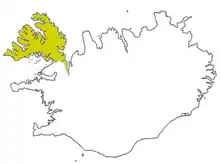Slaying of the Spaniards
The Slaying of the Spaniards (also known as the Spanish Killings; Icelandic: Spánverjavígin) was the last documented massacre in Icelandic history. Some Basque whalers went on a whaling expedition to Iceland and were killed after conflict in 1615 with local people in the region of the Westfjords.
Background
In the first half of the seventeenth century Basque whalers set up the world's first large-scale whaling industry in Newfoundland. The center of this industry was some ten ports on the southern coast of Labrador. During the peak years of the 1560s and 1570s the fleet comprised around 30 ships manned by up to 2,000 men, who killed approximately 400 whales each year. By the beginning of the seventeenth century Basque whaling had reached Iceland.
Massacre

The year 1615 was a difficult year in Iceland with ice up to shores until late summer and considerable loss of livestock. In mid-summer three Basque whaling vessels put into Reykjarfjörður in Westfjords. Icelanders and the Basques had a mutual agreement at the beginning as they both had benefited from the enterprise. When the ships were ready for departure in late September a terrible gale arose and the ships were driven on the rocks and crushed. Most of the crew members survived (approx. 80). The captains Pedro de Aguirre and Esteban de Telleria wintered at Vatneyri (Patreksfjörður) and left for home the following year. The crew of Martin de Villafranca's ship split into two groups; one entered Ísafjarðardjúp, the other went to Bolungarvík and later to Þingeyri.
The first conflict arose when one group entered the empty house of a merchant of Þingeyri and stole some dried fish. As retaliation, on 5 October, at night, a group of Icelanders entered the hut where the Basques were sleeping and killed 14 of them, only one young man called García, escaped. Captain Martín de Villafranca of San Sebastián, whose father and grandfather had both been involved in Terra Nova whaling was among those who were killed. The bodies were mutilated and sunken into water. Jón Guðmundsson the Learned wrote about the unjust and cruel deaths "dishonored and sunken into sea, as if they were the worst pagans and not innocent Christians". Three days after the first slaying, Ari Magnússon summoned a council at Súðavík and twelve judges agreed to declare as outlaws all the Basques.
On 13 October Martin and the other 17 of his group were killed at Æðey and Sandeyri in Ísafjarðardjúp, while they were fishing, by the troops commanded by Ari Magnússon. According to Jón Guðmundsson, the victims were stabbed in the eyes, their ears, noses and had their genitals mutilated. The captain, Martín de Villafranca, was injured in the shoulder and chest with an axe, but he managed to escape into the sea however he was stoned in the water and dragged to the shore where he was tortured to death.
Two verdicts were instigated by sheriff Ari Magnússon of Ögur, Ísafjarðardjúp in October 1615 and January 1616. The Basques were considered criminals after their ships were wrecked and in accordance with the Icelandic law book of 1281 it was decided that the only right thing to do was to kill as many of them as possible. Over 30 Spaniards were killed.[1]
Aftermath
Jón Guðmundsson the Learned (1574–1658) wrote a critical account condemning the decision of the local sheriff to order the killings: A True Account of Spanish Men's Shipwrecks and Slayings. Jón says that they were unjustly killed; not wishing to take part in an attack on them, he fled south to Snæfellsnes.
In 2015, a memorial in honor of the killed Basques was unveiled, with the presence of Martín Garitano, then governor of the Gipuzkoa province in the Basque Country. In the occasion, Westfjords district commissioner Jonas Gudmundsson formally revoked Magnússon's 1615 decree.[1]
References
- "Basques safe in Iceland as district repeals decree to kill them on sight". The Guardian. 2015-05-25. Retrieved 2020-08-28.